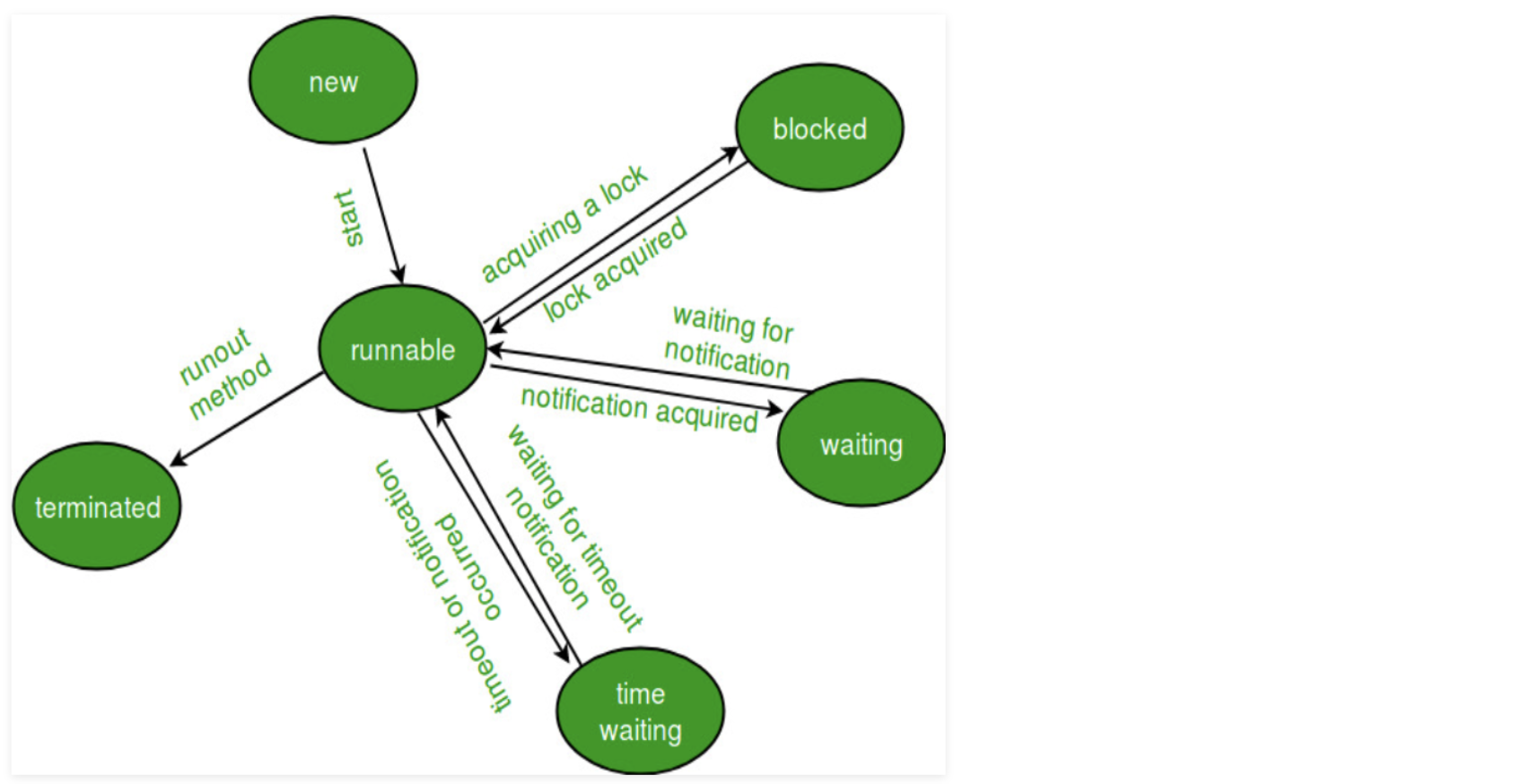线程
线程(英语:thread)是操作系统能够进行运算调度的最小单位。它被包含在进程之中,是进程中的实际运作单位。一条线程指的是进程中一个单一顺序的控制流, 一个进程中可以并发多个线程,每条线程并行执行不同的任务。在Unix System V及SunOS中也被称为轻量进程(lightweight processes), 但轻量进程更多指内核线程(kernel thread),而把用户线程(user thread)称为线程。
以上拷贝自维基百科
代码中任务、逻辑操作都依赖于线程,是java运行时最宝贵的资源
多线程一定程度可以增加cpu使用时间,压榨计算机资源提供更好的使用性能,一定程度也增加了资源的消耗如内存的增长、线程上下文数据切换的消耗、cup资源消耗,实际情况中我们应该根据业务场景合理的使用线程资源
Java线程生命周期
 

java.lang.Thread.State 定义了如下6种线程状态
/**
* Thread state for a thread which has not yet started.
*/
NEW,
/**
* Thread state for a runnable thread. A thread in the runnable
* state is executing in the Java virtual machine but it may
* be waiting for other resources from the operating system
* such as processor.
*/
RUNNABLE,
/**
* Thread state for a thread blocked waiting for a monitor lock.
* A thread in the blocked state is waiting for a monitor lock
* to enter a synchronized block/method or
* reenter a synchronized block/method after calling
* {@link Object#wait() Object.wait}.
*/
BLOCKED,
/**
* Thread state for a waiting thread.
* A thread is in the waiting state due to calling one of the
* following methods:
* <ul>
* <li>{@link Object#wait() Object.wait} with no timeout</li>
* <li>{@link #join() Thread.join} with no timeout</li>
* <li>{@link LockSupport#park() LockSupport.park}</li>
* </ul>
*
* <p>A thread in the waiting state is waiting for another thread to
* perform a particular action.
*
* For example, a thread that has called <tt>Object.wait()</tt>
* on an object is waiting for another thread to call
* <tt>Object.notify()</tt> or <tt>Object.notifyAll()</tt> on
* that object. A thread that has called <tt>Thread.join()</tt>
* is waiting for a specified thread to terminate.
*/
WAITING,
/**
* Thread state for a waiting thread with a specified waiting time.
* A thread is in the timed waiting state due to calling one of
* the following methods with a specified positive waiting time:
* <ul>
* <li>{@link #sleep Thread.sleep}</li>
* <li>{@link Object#wait(long) Object.wait} with timeout</li>
* <li>{@link #join(long) Thread.join} with timeout</li>
* <li>{@link LockSupport#parkNanos LockSupport.parkNanos}</li>
* <li>{@link LockSupport#parkUntil LockSupport.parkUntil}</li>
* </ul>
*/
TIMED_WAITING,
/**
* Thread state for a terminated thread.
* The thread has completed execution.
*/
TERMINATED;
- New:刚创建,可被执行,并且未开始执行
- Runnable:正在执行或随时准备执行,例如多线程程序分配特定时间片给特定线程,特定线程执行短暂时间并暂停放弃cpu时间给其他线程,其他线程因此可以执行,这种场景线程是准备执行等待CPU时间,这种状态即Runnable
- Blocked:waiting for a monitor lock,处于需要获取其他线程锁定的同步资源,如等待io结束,这种状态在转变为Runnable之前无法执行,无法消耗cup时间片
- Waiting:等待其他线程执行特定操作,和Blocked类似
- Timed Waiting:线程调用等待执行场景,特定时间后执行,比较sleep,或者一些条件等待场景,如定时任务
- Terminated:正常或异常结束线程,将不分配CPU时间
模拟线程生命周期
1线程状态转换
public class DemonstrateThreadStates2 {
static Thread thread1;
public static void main(String[] args) {
//创建线程1
thread1 = new Thread(new TestThread1());
// thread1 创建后 NEW state.
System.out.println("State of thread1 after creating it - " + thread1.getState());
thread1.start();
// thread1 调用start后 变成 Runnable state
System.out.println("State of thread1 after calling .start() method on it - " +
thread1.getState());
}
}
class TestThread1 implements Runnable {
@Override
public void run() {
TestThread2 myThread = new TestThread2();
Thread thread2 = new Thread(myThread);
// 线程2创建 NEW state.
System.out.println("State of thread2 after creating it - " + thread2.getState());
thread2.start();
// 线程2调用start 变成 Runnable state
System.out.println("State of thread2 after calling .start() method on it - " +
thread2.getState());
// 调用sleep迫使当前线程进入sleep thread2 = timed waiting state
try {
//moving thread2 to timed waiting state
Thread.sleep(200);
} catch (InterruptedException e) {
e.printStackTrace();
}
System.out.println("State of thread2 after calling .sleep() method on it - " +
thread2.getState());
try {
// 调用join迫使线程结束到die
thread2.join();
} catch (InterruptedException e) {
e.printStackTrace();
}
System.out.println("State of thread2 when it has finished it's execution - " +
thread2.getState());
}
}
class TestThread2 implements Runnable {
@Override
public void run() {
// moving thread2 to timed waiting state
try {
Thread.sleep(1500);
} catch (InterruptedException e) {
e.printStackTrace();
}
System.out.println("State of thread1 while it called join() method on thread2 -" +
DemonstrateThreadStates2.thread1.getState());
try {
Thread.sleep(200);
} catch (InterruptedException e) {
e.printStackTrace();
}
}
}
控制台输出:
State of thread1 after creating it - NEW
State of thread1 after calling .start() method on it - RUNNABLE
State of thread2 after creating it - NEW
State of thread2 after calling .start() method on it - RUNNABLE
State of thread2 after calling .sleep() method on it - TIMED_WAITING
State of thread1 while it called join() method on thread2 -WAITING
State of thread2 when it has finished it's execution - TERMINATED
线程创建线程变成NEW状态,调用start启动线程变成Runnable,调用sleep阻塞当前线程吧变成Timed Waiting,thread2调用join将等待结束当前线程到父线程thread1,thread2线程将变成die,父线程thread1 等待线程thread2结束变成waiting
2模拟blocked场景
通过死锁模拟blocked场景
死锁条件
互斥使用:一个资源只能分配给一个线程
不可剥夺:资源只能由占有者释放,申请者不能强制剥夺
请求保持:线程申请资源时,保持对原有资源的占有
循环等待:存在一个进程等待队列:{P1 , P2 , … , Pn}, 其中P1等待P2占有的资源,P2等待P3占有的资源,…,Pn等待P1占有的资源,形成一个进程等待环路
代码
public class TestDeadLock implements Runnable {
// flag=1,占有对象o1,等待对象o2
// flag=0,占有对象o2,等待对象o1
public int flag = 1;
// 定义两个Object对象,模拟两个线程占有的资源
public static Object o1 = new Object();
public static Object o2 = new Object();
public static void main(String[] args) {
TestDeadLock deadLock1 = new TestDeadLock();
TestDeadLock deadLock2 = new TestDeadLock();
deadLock1.flag = 0;
deadLock2.flag = 1;
Thread thread1 = new Thread(deadLock1);
Thread thread2 = new Thread(deadLock2);
thread1.start();
thread2.start();
}
@Override
public void run() {
System.out.println("flag: " + flag);
// deadLock2占用资源o1,准备获取资源o2
if (flag == 1) {
synchronized (o1) {
try {
Thread.sleep(1000);
} catch (InterruptedException e) {
e.printStackTrace();
}
synchronized (o2) {
System.out.println("1");
}
}
}
// deadLock1占用资源o2,准备获取资源o1
else if (flag == 0) {
synchronized (o2) {
try {
Thread.sleep(1000);
} catch (InterruptedException e) {
e.printStackTrace();
}
synchronized (o1) {
System.out.println("0");
}
}
}
}
}
参考文献
https://www.geeksforgeeks.org/lifecycle-and-states-of-a-thread-in-java/





















 140
140

 被折叠的 条评论
为什么被折叠?
被折叠的 条评论
为什么被折叠?








